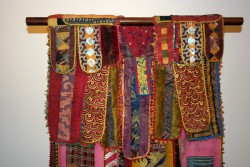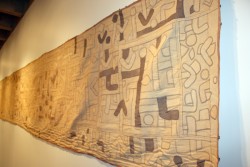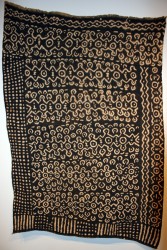 Yoruba ceremonial Egungun dance costume, Nigeria. |
CONTACT: Heather King, 515-271-1994, heather.king@drake.edu
Drake University’s Anderson Gallery will feature “Woven Traditions: Central and West African Textiles,” an exhibition of 40 traditional African textiles from the collection of Drake faculty members Lenore Metrick-Chen and Phillip Chen.
The exhibition, which opens with a reception from 5 to 7 p.m. Friday, Jan. 25, is curated by Edwina Brandon, director of development and external affairs at the Des Moines Art Center. Metrick-Chen, assistant professor of art history, and John Monroe, assistant professor of history at Iowa State University, will lead a gallery talk at 6 p.m.
“Woven Traditions: Central and West African Textiles,” which will continue through Feb. 22, encompasses textiles from West and Central Africa, including works by the Ashante, Yoruba, Nupe, Bamana, Kuba and Pygmy peoples.
“The range of textile design techniques will include weaving, applique and both direct and resist-dye drawing methods,” said Phillip Chen, associate professor of art and design.
 Kuba applique skirt, embroidery and cut pile, The Democratic Republic of the Congo, 17 x 18 in. |
Seldom-seen examples of Pygmy bark cloth drawing will be displayed,
a rare and brilliantly colorful Nigerian dance costume along with a
20-foot Kuba skirt from the Democratic Republic of the Congo.
The Kuba wrap skirts, which are woven by men and patched by women,
are made from 100 percent raffia palm leaf fiber. Once the stiff cloth
is woven, it is softened by a pounding process, which creates holes in
the cloth. Women patch the holes with appliqué for functionality and
decoration. The resulting symbols and patterns form a visual language
that can be understood by initiated individuals amongst the Kuba.
“In the ’70s and ’80s most African collecting consisted of
ceremonial statues and masks with religious significance,” Chen said.
“There were visually interesting and under-appreciated African
household objects more readily available.”
 Bamana mud cloth, Mali. |
Chen and Metrick-Chen started collecting African textiles and art in 1985, as they were less costly than statues and masks. They traveled throughout the United States to Chicago or New York to acquire pieces from commercial galleries and merchants from West Africa.
In addition, Chen said some of the textiles in the collection were gifts. “While I was teaching at the University of Chicago, Illinois, one of my students from Nigeria brought me gifts of his grandmother’s wraps and kept an eye out for other pieces for me,” he added. “It is a tradition in many cultures to bring gifts for teachers, and he knew I enjoyed collecting and examining pieces from around the world.”
The opening reception and exhibition are free and open to the public. Gallery hours are noon to 4 p.m. Tuesday through Sunday. The Anderson Gallery is in the Harmon Fine Arts Center, 25th Street and Carpenter Avenue. For more information, contact Heather King, Director of the Anderson Gallery, at 515-271-1994 or at heather.king@drake.edu.

